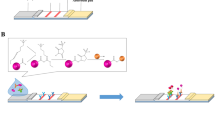Abstract
The avidin-biotin molecular recognition system is widely used in parasite immunology. However, the presence of biotin and/or biotin-containing molecules (BCMs) in samples may lead to erroneous results. In the work reported herein we investigated the extent to which biotin and BCMs present in helminth extracts may interfere in avidin/biotin-based immunoassays and developed an enzyme-linked immunosorbent assay (ELISA) for quantification of these components. In avidin-based ELISA using antinematode monoclonal antibodies, an extract of the nematode Anisakis simplex showed very high background reactivity due to biotin/BCMs, whereas the background reactivity in an extract of the nematode Trichinella spiralis was negligible. To investigate interspecies differences further, we performed Western-blot analyses (with avidin as the detector) of extracts from seven nematodes (A. simplex, Ascaris suum, Toxocara canis, Hysterothylacium aduncum, T. spiralis, and Trichuris muris) and the cestode Bothriocephalus scorpii. Even within superfamilies there was considerable variation in the banding patterns obtained. The above-mentioned results confirm that biotin and BCMs may be a significant source of interference in ELISA and immunoblotting, two of the techniques most widely used in parasitological immunodiagnosis. A competition ELISA designed to allow accurate quantification of biotin and BCMs in helminth extracts likewise indicated very considerable interspecies variation. Both A. simplex and H. aduncum had very high biotin/BCM contents. Microdialysis of extracts in the presence of dimethylsulfoxide to remove free biotin prior to ELISA indicated that the high biotin/BCM content of the H. aduncum extract (but not the A. simplex extract) was very largely due to free biotin. Taken together, these results indicate that extreme caution should be exercised in the use of avidin/biotin-based immunoassays for the detection of helminth antigens and that in many cases it may be better to use an alternative recognition system.
Similar content being viewed by others
Author information
Authors and Affiliations
Additional information
Received: 8 February 1996 / Accepted: 24 April 1996
Rights and permissions
About this article
Cite this article
Romarís, F., Iglesias, R., García, L. et al. Free and bound biotin molecules in helminths: a source of artifacts for avidin biotin-based immunoassays. Parasitol Res 82, 617–622 (1996). https://doi.org/10.1007/s004360050174
Issue Date:
DOI: https://doi.org/10.1007/s004360050174




